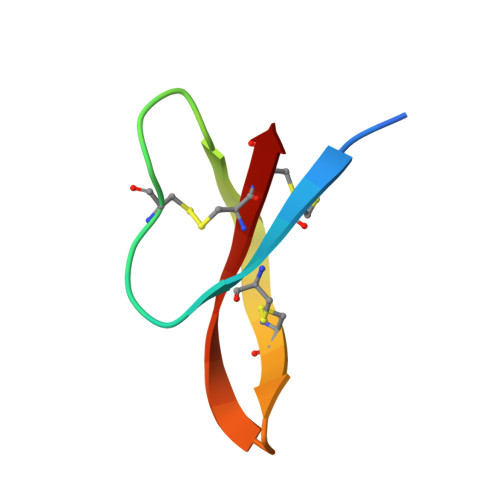Mouse alpha-Defensins: Structural and Functional Analysis of the 17 Cryptdin Isoforms Identified from a Single Jejunal Crypt.
Wang, Q., Yang, Y., Luo, G., Zhou, Y., Tolbert, W.D., Pazgier, M., Liao, C., Lu, W.(2023) Infect Immun 91: e0036122-e0036122
- PubMed: 36472443
- DOI: https://doi.org/10.1128/iai.00361-22
- Primary Citation of Related Structures:
7YOA - PubMed Abstract:
Mouse α-defensins, better known as cryptdins, are host protective antimicrobial peptides produced in the intestinal crypt by Paneth cells. To date, more than 20 cryptdin mRNAs have been identified from mouse small intestine, of which the first six cryptdins (Crp1 to Crp6) have been isolated and characterized at the peptide level. We quantified bactericidal activities against Escherichia coli and Staphylococcus aureus of the 17 cryptdin isoforms identified by Ouellette and colleagues from a single jejunal crypt (A. J. Ouellette et al., Infect Immun 62:5040-5047, 1994), along with linearized analogs of Crp1, Crp4, and Crp14. In addition, we analyzed the most potent and weakest cryptdins in the panel with respect to their ability to self-associate in solution. Finally, we solved, for the first time, the high-resolution crystal structure of a cryptdin, Crp14, and performed molecular dynamics simulation on Crp14 and a hypothetical mutant, T14K-Crp14. Our results indicate that mutational effects are highly dependent on cryptdin sequence, residue position, and bacterial strain. Crp14 adopts a disulfide-stabilized, three-stranded β-sheet core structure and forms a noncanonical dimer stabilized by asymmetrical interactions between the two β1 strands in parallel. The killing of E. coli by cryptdins is generally independent of their tertiary and quaternary structures that are important for the killing of S. aureus, which is indicative of two distinct mechanisms of action. Importantly, sequence variations impact the bactericidal activity of cryptdins by influencing their ability to self-associate in solution. This study expands our current understanding of how cryptdins function at the molecular level.
- Key Laboratory of Medical Molecular Virology (MOE/NHC/CAMS), School of Basic Medical Science, and Shanghai Institute of Infectious Disease and Biosecurity, Fudan University, Shanghai, China.
Organizational Affiliation:

















